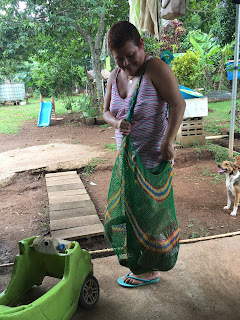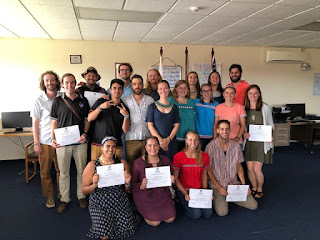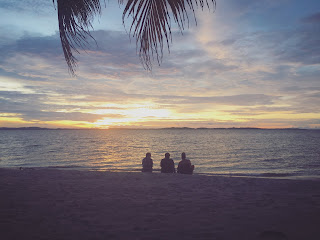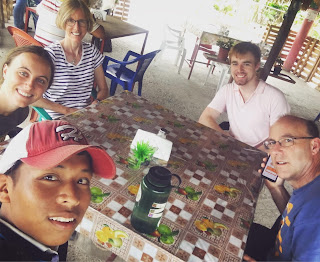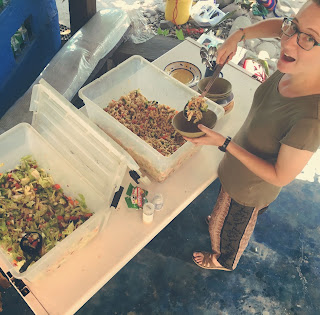I do know how to pay attention, how to fall down
Into the grass, how to kneel down in the grass,
How to be idle and blessed, how to stroll through the fields
which is what I have been doing all day.
Tell me, what else should I have done?
Doesn't everything die at last, and too soon?
Tell me, what is it you plan to do
with your one wild and precious life?
-Mary Oliver
When I first got my invitation to be a Peace Corps Volunteer, I read a lot of blogs by Panama PCVs. The first one I found was from a volunteer serving in the Darien, and ever since then I've dreamed of going to Darien, the province closest to Colombia. It's famous for its untouched rainforest, bird species, Guna, Emberá, and Wounaan indigenous people, and the Darien Gap (read more about that
here), the only break in the pan-American highway that stretches from Alaska to Argentina. There are no public roads between Panama and Colombia, in part due to violence by the FARC and drug trafficking...pretty fascinating.
Anyways, I finally got the chance to go to the Darien this month. There are only five volunteers out there and they don't have a regional leader, so I got to do a mid-service RL visit for an agriculture volunteer, Nick, better known to his gente as
Bichichi, the Emberá word for a type of small brown and white monkey. To get to his community from Panama City, you have to take a 6-hour bus, 30 minute busito, a 2.5-hour boat ride through river & ocean, catch a 30-minute ride on the back of a pickup truck, then hike for an hour. But once you get there, you quickly understand that this community is a place so idyllic & self-sufficient that you would almost never need nor want to leave!! We met one of Nick's counterparts and he almost immediately decided that I was going to be called
Imbisuwena, which means lady hummingbird in Emberá. Since I was only going to be there for two days I wasn't even expecting to receive a name, so I was happily surprised. I relate to hummingbirds for many reasons (always flying around busily being one lol), so for him to see me and immediately think 'hummingbird' was pretty cool. Nick lives in a bamboo house on stilts with a palm thatch roof, a typical style for the community. All of the houses there were spacious and felt like treehouses, and each one had a log with footholds carved in to climb up into the house. I had to shakily climb with both hands, and I watched women swiftly glide up the ladder hands-free, carrying huge pailas or babies...
The community is primarily dedicated to agriculture, just like the Ngäbe communities we work in. But there are many interesting differences in how the communities function. The Emberá population is much smaller than the Ngäbe population (maybe about an eighth of the size? I have to fact check this) and it seems like each community has a lot of projects from various agencies going on, whereas in the Comarca Ngäbe-Buglé projects tend to be concentrated in the big communities along the roads. In this tiny site of only 20-some households, they have a reforestation project where they were caring for baby trees in a nursery to sell to a nearby Latino community that struggles with deforestation caused by all the cow pastures. They had recently built a solar dryer, mostly for coffee but also for drying other fruits and grains. They have a women's artisan group, an environmental conservation group, a tourism project with houses for passing backpackers to rent, a water committee, and a coffee producers group with a generator-powered
piladora (hulling machine). The amazing thing is that the projects are all locally led.
The isolation of the community causes them to rely mostly on what they grow, forage, and catch for food, another difference from the CNB where a lot of food nowadays is bought. In the two days I was there we ate locally grown tomatoes and okra, shrimp and fish from the river, rice and plantain from the finca, and locally raised pork and beef. I was completely overwhelmed with all of the protein! The houses are all clustered around a central area with a school and soccer field, and right next to a river. The river is used for bathing, dishes, washing clothes, etc, and is a very social area. This is a sharp contrast to what I'm used to, with most of the sites we work in in the Comarca being very spread out and higher up in the mountains, using individual streams instead of a big shared river. Nick spoke amazing Emberá and seemed to be truly thriving there, it was fun to visit. He knows a ton about bird and plant species and identified almost every bird we saw and interesting flower and tree we passed, not to show off, just out of habit. It was pretty impressive, and cool to see all of the biodiversity there.
So what else have I been up to?!?
In June I finished up site preparation for the new group that arrived in county mid-June, went to a conference with Comarca leaders and some American and Canadian universities, visited volunteers in their sites, and got to march in the Panamanian Pride Parade with the US Embassy. In July, I went home to Michigan and Wisconsin for about two weeks to see friends and family and attend Abby's and Sana's weddings! I also had two job interviews for post-PC positions, more on that below...
After I got back to Panama I jumped right into action coordinating the delivery of letters to the fifteen communities that were selected to receive volunteers in August. That had me running around for a couple weeks and making lots of phone calls back and forth to make sure the host families had the new volunteers' bedrooms all constructed and secured (a lot of families have to build brand-new bedrooms because most houses are not divided, everyone sleeps in the same room). Then we went to the city for site announcement. It was actually really satisfying seeing all of the site prep work I've dedicated myself to since January pay off as the trainees excitedly received their site placements!!
My last few weeks in Panama I'm spending visiting the 14 G83 volunteers for their mid-service visits. It has been amazing to see how they've grown since I did their initial visits last October, and it's fun hanging out with them in their sites, visiting their best friends in site and seeing how much the neighborhood kids adore them, and cooking bomb food in their campo kitchens. Last weekend during a visit I noticed that a bug bite on my thigh was getting swollen and was starting to hurt. I showed it to a couple other volunteers who recognized it as a
nacido, a skin infection that can swell really big, and they told me to call our PC doctors asap. So they sent me to the clinic for antibiotics, no problem. But then it kept growing into a very swollen, purple colored abscess that hurt every step I took. So they sent me back to the clinic, where they gave me even stronger antibiotics and local anesthesia, punctured the abscess, drained it, cleaned it, bandaged it, and gave me a bunch of meds to take home. The pain went away immediately after this, and as always I gave thanks for my access to healthcare. I had seen various community members get these, and not always have resources to go see a doctor. Panama, you never fail to keep me on my toes!!!
Oh also, I wanted to mention that my Chacos broke so for the rest of my service my shoes of choice are my off-brand Crocs - I have been doing basically all my hiking in these $3 shoes and love them -- why did it take me so long to catch on?
Finally, I accepted a job post-Peace Corps! I haven't gotten my official legal clearance yet, so I won't give many details and I don't have a start date, but hopefully around early November I'll be cleared to begin. Dios primero, I will be working as an environmental engineer for the federal government in the Seattle, Washington area & I'm very excited!
Photo dump:
Nick's community in the Darien
Huge tree, there were so many of these. I rarely ever see trees this big in the Comarca
Pretty waterfall and swimming hole we hiked to. I jumped off the ledge (20 ft or so?) to the left of the waterfall. Mildly terrifying but exhilarating
Another view of the community. It's very close-knit, you can walk to most houses within 15 minutes. It even has a sidewalk!
Typical Emberá house with parumas hanging out to dry (brightly colored wrap skits in floral, animal, and geometric designs that all of the women wear)
Anti-drug trafficking poster at Nick's host fam's house
Tree nursery for the reforestation project
One of my favorite families, these guys were always fun to hang out with and there was ALWAYS a paila of cacao at their house
Although I try to convince myself and others that I'm too healthy to eat salchicha (hot dogs), I admit that I get a teeny bit excited when I go to an event and see salchicha guisada & bollos for breakfast
Marching in the Pride Parade in Panama City. This march was not to protest or push for legislation, only to show support to the LGBTQ+ community. It made me a little emotional, seeing all of the couples holding hands and wearing matching rainbow outfits, enjoying the only afternoon of the year in Panama that they could openly be themselves and have their love celebrated, not condemned.
Sign making and t-shirt decorating in the PC office the day before the parade, with Aziza.
Súper ofi invite to an event from an agricultural agency (notice my painted hands & feet from the Darien)
I got to be a guest judge for a science fair at a nearby bilingual elementary school, all of the kids presented their projects in English! Very brave students.
Visiting Chantal in her site with Shellee and our boss Daniel!
Helped facilitate a charla on gender roles and inclusion for a women's group. This is Doris, a very outspoken woman and lifesaving Ngäbere translator for us, presenting the results of an activity to the group.
Doing a dinámica led by Corina in a brand-new super motivated community that just welcomed their first WASH volunteer
Corbyn shaving off the green part of the agave plant with the dull side of a machete, to separate the internal fibers which will be used to make thread to weave chácaras (the woman in the turquoise nagua was very impressed by his knack for it)
Helping Elena with a water committee seminar
Casual shopping trip with Abby for a dinner to feed 25 in Boquete
Facilitating my final
Elige Tu Vida in Hato Pilón with Ian and Lucy. This was one of my favorite seminars to give here in Panama. If I'm counting right, I think I facilitated it 14 times!
Another water committee seminar!
I asked Ian's host family if they wanted a family photo and it turned into a half-hour photoshoot along with several outfit changes haha, here are two of his three siblings (my hands are green because I was painting a world map the day before and it was hard to get the paint off haha)
Visiting Courtney, she's showing some gente her worm compost bucket
Some of the Comarca volunteers at our goodbye party for the volunteers finishing their service in August and September
Feeling grateful for this life I get to live for two more weeks. I fly home September 19th! Chao, pesca'os.






